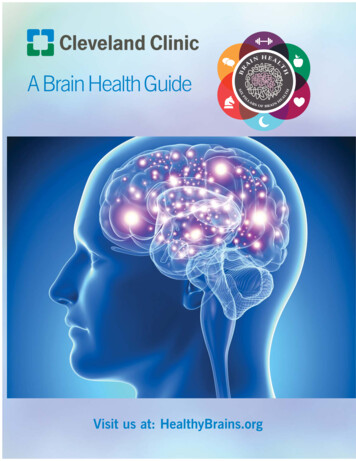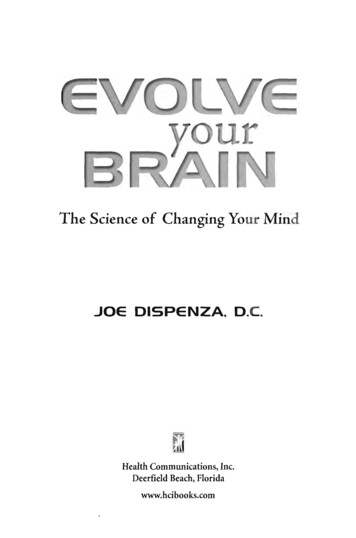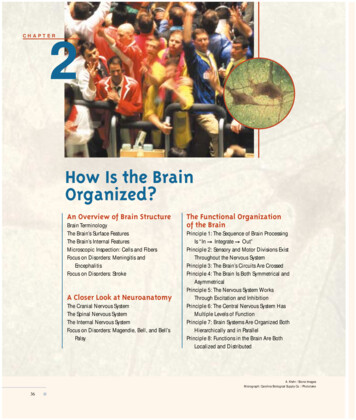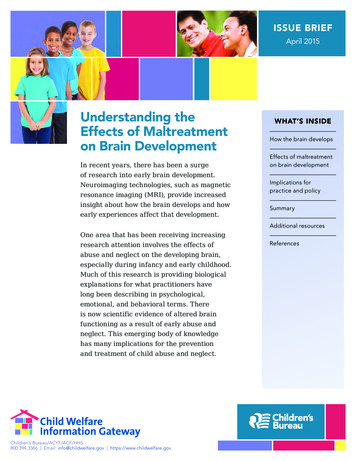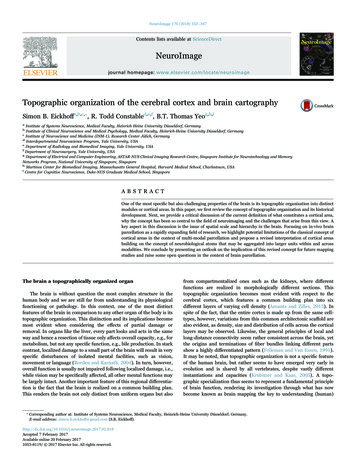
Transcription
Praise for Evolve Your Brain“Dr. Joe Dispenza delves deep into the extraordinary potential of themind. Read this book and be inspired to change your life forever.”—Lynne McTaggart, author of The Field and The Intention Experiment“A beautifully written book that provides a strong scientific basis forhow the power of the human spirit can heal our bodies and our lives.”—Howard Martin, executive vice president of HeartMath and coauthorof The HeartMath Solution“Joe Dispenza gives you the tools to make real changes in your life.”—William Arntz, producer/director of What the Bleep Do We Know!?“A groundbreaking work on what I call the ‘yoga of the mind.’ Aperceptive and insightful look at how our mental and emotional bodiesfunction and how we can create a more healthy and purposeful life.”—Bikram Choudhury, author of Bikram Yoga“Through the integration of personal experience, Western science, andEastern thought, Dr. Joe brings a lucid and inspiring story that willchange your life.”—Michael T. Lardon, M.D., consulting psychiatrist for the San DiegoOlympic Training Center and the PGA Tour “Evolving Your Brain isn’t justa book; it is an opportunity for anyone who is serious about becomingmore and having more to learn exactly how to do it from the inside out.”—John Assaraf, author of The Street Kids Guide to Having It All andfounder of Onecoach“Approachable, accessible, and empowering, Joe Dispenza helps makesense of this wacky world we call reality.”—Betsy Chasse, writer/director/producer of What the Bleep Do We
Know!?
EVOLVEyourBRAINThe Science of Changing Your MindJOE DISPENZA, D.C.Health Communications Inc.Deerfield Beach, Floridawww.hcibooks.com
The content of this book is published for educational and informational purposes only. Thecontent of this book should not be used for the diagnosis or treatment of any condition ordisease. The case histories presented are provided for illustrative purposes only. No express orimplied guarantee of results is made. If you are currently being treated by a physician or otherhealthcare practitioner for any condition or disease, consult with that provider prior to changingor modifying any treatment program.Library of Congress Cataloging-in-Publication Datais available through the Library of Congress. 2007 Joe Dispenza, D.C.ISBN-13: 978-0-7573-0765-2 (paperback)ISBN-10: 0-7573-0765-5 (paperback)ISBN-13: 978-0-7573-9779-0 (e-book)ISBN-10: 0-7573-9779-4 (e-book) All rights reserved. Printed in the United States of America. Nopart of this publication may be reproduced, stored in a retrieval system, or transmitted in anyform or by any means, electronic, mechanical, photocopying, recording, or otherwise, withoutthe written permission of the publisher.HCI, its logos and marks are trademarks of Health Communications, Inc.Publisher: Health Communications, Inc.3201 S.W. 15th StreetDeerfield Beach, FL 33442-8190R-10-08Cover design by Larissa Hise HenochInterior book design and formatting by Lawna Patterson OldfieldInterior illustrations by Larissa Hise Henoch
FORJACE, GIANNA, AND SHENARA
CONTENTSACKNOWLEDGMENTSFOREWORD BY AMIT GOSWAMI, PH.DCHAPTER ONE: BeginningsCHAPTER TWO: On the Back of a GiantCHAPTER THREE: Neurons and the Nervous System: Traveling the OriginalInformation SuperhighwayCHAPTER FOUR: Our Three Brains and MoreCHAPTER FIVE: Wired by Nature, Changeable by NurtureCHAPTER SIX: Neuroplasticity: How Knowledge and Experience Changeand Evolve the BrainCHAPTER SEVEN: Putting Knowledge and Experience into PracticeCHAPTER EIGHT: The Chemistry of SurvivalCHAPTER NINE: The Chemistry of Emotional AddictionCHAPTER TEN: Taking Control: The Frontal Lobe in Thought and in ActionCHAPTER ELEVEN: The Art and Science of Mental RehearsalCHAPTER TWELVE: Evolving Your Being
Epilogue: A Quantum ChangeNotesIndex
ACKNOWLEDGMENTSCreation is such an interesting phenomenon. The process is riddledwith a landscape of peaks and valleys with indeterminate views.There are moments when we feel truly inspired and uplifted,because we have made some progress in climbing to a new level to see abetter view. In the next moment, when we see that there are biggerobstacles to overcome, we wonder if we even made a difference and ifour efforts were really worth it. Like the birthing process, creation comeswith labor pains, complications, nausea, fatigue, sleepless nights, andeven woeful moments of thinking about the future. Questions lurk aboutour personal abilities, what we know, what we don’t know, who ourcritics are, who we are doing this for anyway, and why. I have had suchmoments in writing this book.And yet, it is almost natural that we fret with such encumbrances,because somewhere inside us, we know that the only terrain we areovercoming is our limited view of ourselves. It’s a process, and mostcertainly, there are speed bumps along the way. I must say that thisbook has been a great and wonderful teacher for me. I am differenttoday because I continued on in spite of the many reasons to stop. Iunderstand better now why I wrote this book. My sole purpose andhopeful intentions were to contribute toward helping people changetheir lives. If this book makes a difference in even one person’s life, thenthe whole process was worth it. Evolve Your Brain was not writtenprimarily for the scientist, the researcher, or the academic, but for theaverage person who wants to understand that science supports ourability to change, and that we, as human beings, have great potential.I certainly do not know everything there is to know about the brain.What I have come to learn, to experience, to research, and to personallyconclude are only doorways to greater understandings. Some might sayto me, why didn’t you discuss this topic or that topic in the book?Simply, I have chosen to keep this body of work about the science ofchanging our mind and what implications this has for our health and ourwell-being. There are many more subjects I could have discussed about
energy, mind, quantum physics, and our greater abilities that wouldmake this book too broad to be useful. My epilogue suggests greaterapplications.I do want to acknowledge several people who have supported,influenced, and inspired me to complete the book. First, I want to thankmy publishers at HCI, Peter Vegso and Tom Sand, who believed in me. Aspecial thank you to my editor, Michele Matrisciani. I also want toexpress my appreciation to Carol Rosenberg for being such a thoroughmanaging editor and to Dawn Von Strolley Grove and Lawna PattersonOldfield for their production expertise.To Tere Stouffer, my copy editor, who helped me with perspective.Also, to Sara Steinberg, my content/copy editor, who taught me aboutthe tortoise and the hare and who showed such caring and love I amgrateful. To Gary Brozek, your contribution to my work is trulyappreciated. My graphic artist Larissa Hise Henoch showed her truetalent in this book.I also want to give my acknowledgments to my staff for keeping upwith my pace. Thanks to Bill Harrell, D.C., Jackie Hobbs, Diane Baker,Patty Kerr, Charlie Davidson, and Brenda Surerus. Your sincerity isinvaluable to me. Special gratitude is given to Gabrielle Sagona for herassistance, encouragement, and fabulous energy. Thank you foreverything. To Joanne Twining, Ph.D., I am expanded by your skills,your knowledge, and your patience. To Will Arntz, James Capezio, andRebecca Capezio for their important feedback with the manuscript. ToMarjorie Layden, Henry Schimberg, Linda Evans, Anne MarieBennstrom, Ken Weiss, Betsy Chasse, and Gordon J. Grobelny, D.C., fortrue encouragement and support. My immense appreciation goes to PaulBurns, J.D., D.C., who helped me in innumerable ways.I also want to give thanks to JZ Knight for giving her life to helphumanity. To Ramtha, who inspired me to write this book and fromwhom I have learned enough to think about for a hundred lifetimes. Tothe students at RSE, who live their lives with a passion for adventureand a love of God. I am always inspired by their dedication to the greatwork.My gratitude to Amit Goswami, Ph.D., for his brilliant intellectual
mind, true compassion, and willingness to be an individual. You are amaverick. Thank you as well to Nick Pappas, M.D., Margie Pappas, R.N.,M.S., and John Kucharczyk, Ph.D., who played an important role ininforming me about the brain, mind, and body.I want to personally thank John and Katina Dispenza and my mother,Fran Dispenza, for having strong shoulders to lean on. And finally, aprofound thank you should be written across the sky to my lovely ladyRoberta Brittingham, for naturally being and living everything that Ihave tried to explain in this book. I am always inspired by your humilityand greatness.
FOREWORDSince you are holding this book in your hand, you may already beaware of the paradigm shift that is going on in science. In the oldparadigm, your consciousness—you—is regarded as anepiphenomenon of your brain. In the new paradigm, your consciousnessis the ground of being and your brain is the epiphenomenon. Feel better?Then you are ready to reap the benefit of this book.If consciousness is the primary ground and brain is secondary, then itis natural to ask how to use the brain in an optimal fashion to fulfill thepurpose of consciousness and its evolution. The new paradigm researchhas been going on for a while, but this is the first book that addressesthis question and brilliantly guides you toward that end. Truly, Dr. JoeDispenza has written a user’s manual par excellence for the brain, fromthe new primacy-of-consciousness perspective.Dr. Dispenza, not being a quantum physicist, does keep the primacy ofconsciousness implicit, not explicit, until the very end of the book.Because it requires quantum physics to see the primacy of consciousnessexplicitly, it may be useful for you, dear reader, to receive a littlebackground information from a quantum physicist; hence, this foreword.To go back to the beginning of the new paradigm revolution, quantumphysics has a fundamental interpretational problem. It depicts objectsnot as determined “things,” but as waves of possibility. How do thesepossibilities become actual “things” of our experience when we observeor “measure” them? If you think that our brain—being the site of us, orour consciousness—has the capacity to change possibility into actuality,think again. According to quantum physics, the brain itself consists ofquantum possibilities before we measure it, before we observe with it. Ifwe, our consciousness, were a brain product, we would be possibilitiesas well, and our “coupling” with the object would change neither theobject nor us (our brain) from possibility to actuality. Face it! Possibilitycoupled to possibility only makes a bigger possibility.The paradox only thickens if you think of yourself dualistically—you
as a nonmaterial dual entity, not bound by quantum laws and separatefrom your brain. But if you are nonmaterial, then how do you interactwith your brain, with which you have not a thing in common? This isdualism, a philosophy intractable as science.There is a third way of thinking, and this one leads to a paradigmshift. Your consciousness is the primary fabric of reality, and matter(including the brain and the object you are observing) exists within thisfabric as quantum possibilities. Your observation consists of choosingfrom the possibilities the one facet that becomes the actuality of yourexperience. Physicists call this process the collapse of the quantumpossibility wave.Once you recognize that your consciousness is not your brain buttranscends it, once you recognize that you have the power to chooseamong possibilities, you are ready to act on Joe Dispenza’s ideas andsuggestions. It will help additionally to know that the “you” that choosesis a cosmic you, a state of consciousness available to you in non-ordinarysituations. You reach such states when you have a creative insight. Inthose times, you are ready to make changes in your brain circuits. Dr.Dispenza shows you how.There is another reason that I think Dr. Joe Dispenza’s book is awelcome addition to the growing literature of the new paradigm ofscience: he emphasizes the importance of paying attention to emotions.You may already have heard the phrase emotional intelligence. What doesthat mean? First of all, it means that you don’t have to fall prey to youremotions. You do because you are attached to them; or as Joe Dispenzawould say, “You are attached to the brain circuits connected with theemotions.”There is a story that when Albert Einstein was leaving Nazi Germanyfor America, his wife became very concerned that she had to leavebehind so much furniture and other household items. “I am attached tothem,” she complained to a friend. To this, Einstein joked, “But my dear,they are not attached to you.”This is the thing. Emotions are not attached to you; because you arenot your brain, you don’t have to identify with your existing braincircuits.
With regard to the concept of emotional intelligence, some writers area little confused. They talk about emotional intelligence and how youcan develop it, but they also insist that you are nothing but the brain.The problem in thinking that way is that the brain is already set up in ahierarchical relationship with the emotions. Emotional intelligence ispossible only if you can change this existing hierarchy, only if you arenot part of that hierarchy. Joe Dispenza recognizes the primacy of you,your consciousness, over your brain, and by doing so, he gives you someuseful advice about emotional intelligence, about how to change yourexisting brain circuits and hierarchies.Gandhi’s wife was once asked by a journalist how Gandhi couldaccomplish so much. “Simple,” said the wife. “Gandhi is congruent inregards to his speech, thought, and action.”All of us want to be good accomplishers; we want to fulfill themeaning and purpose of our lives. The crucial challenge is how toachieve synchrony between speech, thought, and action. Put anotherway, the challenge is to integrate thought and emotion. I believe that theevolution of consciousness demands this from us right now. Recognizingthis, Joe Dispenza has provided indispensable knowledge on how youcan integrate your feelings and thinking.I met Dr. Joe for the first time at a What the Bleep Do We Know!?conference. This movie, as you may know, is about a young woman whois struggling to change her emotional behavior. In a scene of catharsis(played beautifully by actress Marlee Matlin), the woman looks at herimage in a mirror and says, “I hate you.” In that moment she freesherself to choose among quantum possibilities of change. She goes on totransform her brain circuits, creating a new state of being and a new life.You can change your brain circuits, too. You have that power ofquantum choice. We have always had the tools to do this, but only nowhave we become aware of how to use them. Dr. Joe Dispenza’s book,Evolve Your Brain, will help you use your power to choose and to change.Read this book, use its ideas in your life, and realize your potential.—Amit Goswami, Ph.D.Professor of Physics, University of Oregon,and author of The Self-Aware Universe
CHAPTER ONEBEGINNINGSIBut strange that I was not toldThat the brain can holdIn a tiny ivory cellGod’s heaven or hell.—OSCAR WILDEinvite you to have a single thought, any thought. Whether yourthought was related to a feeling of anger, sadness, inspiration, joy,or even sexual arousal, you changed your body. You changed you.All thoughts, whether they be “I can’t,” “I can,” “I’m not good enough,”or “I love you,” have the same measurable effects. As you sit casuallyreading this page, not lifting a single finger, bear in mind that your bodyis undergoing a host of dynamic changes. Triggered by your most recentthought, did you know that suddenly, your pancreas and your adrenalglands are already busy secreting a few new hormones? Like a suddenlightning storm, different areas of your brain just surged with increasedelectrical current, releasing a mob of neurochemicals that are toonumerous to name. Your spleen and your thymus gland sent out a masse-mail to your immune system to make a few modifications. Severaldifferent gastric juices started flowing. Your liver began processingenzymes that were not present moments before. Your heart ratefluctuated, your lungs altered their stroke volume, and blood flow to thecapillaries in your hands and feet changed. All from just thinking onethought. You are that powerful.But how are you capable of performing all of those actions? We can allintellectually understand that the brain can manage and regulate manydiverse functions throughout the rest of the body, but how responsible
are we for the job our brain is doing as CEO of the body? Whether welike it or not, once a thought happens in the brain, the rest is history. Allof the bodily reactions that occur from both our intentional orunintentional thinking unfold behind the scenes of our awareness. Whenyou come right down to it, it is startling to realize how influential andextensive the effects of one or two conscious or unconscious thoughtscan be.For example, is it possible that the seemingly unconscious thoughtsthat run through our mind daily and repeatedly create a cascade ofchemical reactions that produce not only what we feel but also how wefeel? Can we accept that the long-term effects of our habitual thinkingjust might be the cause of how our body moves to a state of imbalance,or what we call disease? Is it likely, moment by moment, that we trainour body to be unhealthy by our repeated thoughts and reactions? Whatif just by thinking, we cause our internal chemistry to be bumped out ofnormal range so often that the body’s self-regulation system eventuallyredefines these abnormal states as normal, regular states? It’s a subtleprocess, but maybe we just never gave it that much attention until now.My wish is that this book will offer a few suggestions for managing yourown internal universe.Since we are on the subject of attention, now I want you to payattention, become aware, and listen. Can you hear the hum of therefrigerator? The sound of a car passing by your home? A distant dogbarking? How about the resonance of your own heart beating? Just byshifting your attention in those moments, you caused a power surge andvoltage flux of electricity in millions of brain cells right inside your ownhead. By choosing to modify your awareness, you changed your brain.Not only did you change how your brain was working moments before,but you changed how it will work in the next moment, and possibly forthe rest of your life.As you return your attention to these words on this page, you alteredblood flow to various parts of your brain. You also set off a cascade ofimpulses, rerouting and modifying electrical currents to different brainareas. On a microscopic level, a multitude of diverse nerve cells gangedup chemically to “hold hands” and communicate, in order to establishstronger long-term relationships with each other. Because of your shift in
attention, the shimmering three-dimensional web of intricateneurological tissue that is your brain is firing in new combinations andsequences. You did that of your own free will, by changing your focus.You quite literally changed your mind.As human beings, we have the natural ability to focus our awarenesson anything. As we will learn, how and where we place our attention,what we place our attention on, and for how long we place it ultimatelydefines us on a neurological level. If our awareness is so mobile, why isit so hard to keep our attention on thoughts that might serve us? Rightnow, as you continue to concentrate and read this page, you might haveforgotten about the pain in your back, the disagreement you had withyour boss earlier today, and even what gender you are. It is where weplace our attention and on what we place our attention that maps thevery course of our state of being.For example, we can, in any given moment, think about a bittermemory from our past that is only tattooed in the intimate folds of ourgray matter and, like magic, it comes to life. We also have the option ofattending to future anxieties and worries that do not readily exist untilthey are conjured up by our own mind. But to us, they are real. Ourattention brings everything to life and makes real what was previouslyunnoticed or unreal.Believe it or not, according to neuroscience, placing our attention onpain in the body makes pain exist, because the circuits in the brain thatperceive pain become electrically activated. If we then put our fullawareness on something other than pain, the brain circuits that processpain and bodily sensations can be literally turned off—and presto, thepain goes away. But when we look to see whether the pain is gone forgood, the corresponding brain circuits once again activate, causing us tofeel the discomfort return. And if these brain circuits repeatedly fire, theconnections between them become stronger. Thus by paying attention topain on a daily basis, we are wiring ourselves neurologically to developa more acute awareness of pain perception, because the related braincircuits become more enriched. Your own personal attention has thatmuch of an effect on you. This could be one explanation to how pain,and even memories from our distant past, characterize us. What werepeatedly think about and where we focus our attention is what we
neurologically become. Neuroscience finally understands that we canmold and shape the neurological framework of the self by the repeatedattention we give to any one thing.Everything that makes us up, the “you” and the “me”—our thoughts,our dreams, our memories, our hopes, our feelings, our secret fantasies,our fears, our skills, our habits, our pains, and our joys—is etched in theliving latticework of our 100 billion brain cells. By the time you haveread this far in the book, you have changed your brain permanently. Ifyou learned even one bit of information, tiny brain cells have made newconnections between them, and who you are is altered. The images thatthese words created in your mind have left footprints in the vast, endlessfields of neurological landscape that is the identity called “you.” This isbecause the “you,” as a sentient being, is immersed and truly exists inthe interconnected electrical web of cellular brain tissue. How yournerve cells are specifically arranged, or neurologically wired, based onwhat you learn, what you remember, what you experience, what youenvision for yourself, what you do, and how you think about yourself,defines you as an individual.You are a work in progress. The organization of brain cells that makesup who you are is constantly in flux. Forget the notion that the brain isstatic, rigid, and fixed. Instead, brain cells are continually remolded andreorganized by our thoughts and experiences. Neurologically, we arerepeatedly changed by the endless stimuli in the world. Instead ofimagining nerve cells as solid, inflexible, tiny sticks that are assembledtogether to make up your brain’s gray matter, I invite you to see them asdancing patterns of delicate electric fibers in an animated web,connecting and disconnecting all the time. This is much closer to thetruth of who you are.The fact that you can read and comprehend the words on this page isdue to the many interactions you have had throughout your life.Different people taught you, instructed you, and essentially changedyour brain microscopically. If you accept this notion that your brain isstill changing as you read these pages before you, you can easily see thatyour parents, teachers, neighbors, friends, family, and culture havecontributed to who you are presently. It is our senses, through ourdiverse experiences, that write the story of who we are on the tablet of
our mind. Our mastery is being the fine conductor of this remarkableorchestra of brain and mind; and as we have just seen, we can direct theaffairs of mental activity.Now, let’s change your brain a little further. I want to teach you a newskill. Here are the instructions: Look at your right hand. Touch yourthumb to your pinky finger, and then touch your thumb to your indexfinger. Next, touch your thumb to your ring finger, and then touch yourthumb to your middle finger. Repeat the process until you can do itautomatically. Now do it faster and make your fingers move morerapidly without mistake. Within a few minutes of paying attention, youshould be able to master the action.To learn the finger movements well, you had to rise out of yourresting state, from relaxing and reading to a heightened state ofconscious awareness. Voluntarily, you perked up your brain a little; youincreased your level of awareness by your intentional free will. Tosucceed in memorizing this skill, you also had to increase your brain’slevel of energy. You turned up the dimmer switch to the light bulb inyour brain that is constantly on, and it got brighter. You becamemotivated, and your choice to do this made your brain turn on.Learning and performing the activity required you to amplify yourlevel of awareness. By increasing blood flow and electrical activity todifferent areas in your brain, you could stay more present with what youwere doing. You kept your brain from wandering to any other thoughtso that you could learn a new action, and that process took energy. Youchanged the way the arrangement of millions of brain cells fired indiverse patterns. Your intentional act took will, focus, and attention. Theend result is that you are once again neurologically changed, not only bythinking a thought but also by demonstrating an action or a new skill.In a moment, I want you to close your eyes. This time, instead ofphysically demonstrating the finger exercise, I want you to practice doingthat same action in your mind. That is, remember what you did justmoments before and mentally touch each finger the way I asked you toearlier: thumb to pinky finger, thumb to index finger, thumb to ringfinger, and thumb to middle finger. Mentally rehearse the activitywithout physically doing it. Do it a few times in your mind, and thenopen your eyes.
Did you notice that while you were practicing in your mind, yourbrain seemed to imagine the entire sequence just as you actually did it?In fact, if you paid full attention to what you were rehearsing in yourmind’s eye by focusing on mentally practicing those finger actions, youfired the same set of nerve cells in the same part of your brain as if youwere actually doing them. In other words, your brain did not know thedifference between your doing the action or your remembering how todo the action. The act of mental rehearsal is a powerful way you cangrow and mold new circuits in your brain.Recent studies in neuroscience demonstrate that we can change ourbrain just by thinking. So ask yourself: What exactly do you spend mostof your time mentally rehearsing, thinking about, and finallydemonstrating? Whether you consciously or unconsciously fabricate yourthoughts and actions, you are always affirming and reaffirming yourneurological self as “you.” Keep in mind that whatever you spend yourtime mentally attending to, that is what you are and what you willbecome. My hope is that this book will help you to understand why youare the way you are, how you got this way, and what it takes to changewho you are through your intentional thoughts and actions.You may ask at this point, What is it that allows us to voluntarilymodify how the brain works? Where does the “you” exist, and whatallows you to turn on and off different brain circuits that then make youaware or unaware? The “you” I’m talking about operates and lives in apart of the brain called the frontal lobe, and without the frontal lobe,you are no longer “you.” In evolution, the frontal lobe has been the lastpart of the brain to develop, just behind the forehead and right abovethe eyes. You hold the image of yourself in the frontal lobe, and whatyou hold in this special place determines how you interact in the worldand perceive reality. The frontal lobe controls and regulates other, olderparts of the brain. The frontal lobe navigates your future, controls yourbehavior, dreams of new possibilities, and guides you throughout life. Itis the seat of your conscience. The frontal lobe is evolution’s gift to you.This brain region is most adaptable to change and is the means by whichyou evolve your thoughts and actions. My desire is that this book helpsyou to use this newest, most recent part of your brain’s anatomy toreshape your brain and your destiny.
Evolution, Change, and NeuroplasticityWe humans have a unique capacity to change. It is via the frontal lobethat we go beyond the preprogrammed behaviors that are geneticallycompartmentalized within the human brain, the recorded history of ourspecies’ past. Because our frontal lobe is more evolved than that of anyother species on earth, we have tremendous adaptability, and with itcome choice, intent, and full awareness. We possess an advanced bit ofbiotechnology that allows us to learn from our mistakes andshortcomings, to remember, and to modify our behavior so that we cando a better job in life.It is true that a lot of human behavior is genetically preset. All lifeforms are preordained to be what they genetically express, and we mustagree that a lot of who we are as human beings is predetermined by ourgenes. Yet we are not condemned to live out our existence withoutcontributing some form of an evolutionary gift to future generations. Wecan add to our species’ progress here on earth because unlike otherspecies, we theoretically have the hardware to evolve our actions in onelifetime. The new behaviors we demonstrate will provide newexperiences that should be encoded in our genes—both for now and forposterity. This leads us to consider: How many new experiences have wehad lately?The science of molecular bi
“A beautifully written book that provides a strong scientific basis for how the power of the human spirit can heal our bodies and our lives.” —Howard Martin, executive vice president of HeartMath and coauthor of The HeartMath Solution “Joe Dispenz






